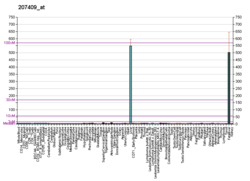LECT2 amyloidosis
LECT2 amyloidosis (ALECT2) was the third most common (~3% of total) cause of amyloidosis in a series of >4,000 individuals studied at the Mayo Clinic in the United States. However, LECT2 amyloidosis has a strong ethnic bias, afflicting particularly Mexicans and to a lesser extent, non-Mexican Hispanics. Hispanics made an important contribution to the Mayo Clinic's rate of LECT2 amyloidosis. LECT2 amyloidosis also has an increased incidence in Punjabis, South Asians, First Nations people of British Columbia, Native Americans, and Egyptians. In Egyptians, LECT2 is second most common cause of renal amyloidosis, accounting for nearly 31% of all cases. LECT2 amyloidosis is likely to be a far less common cause of systemic amyloidosis in populations containing fewer numbers of individuals of the cited ethnic groups. [8] [11] [12] On the other hand, LECT2 amyloidosis represents an important but at present very much under-recognized cause of chronic kidney disease in the cited ethnic groups and, possibly, other ethnic groups yet to be determined. [13]
It has been found repeatedly that the mere presence of LECT2 amyloid tissue deposits does not necessarily indicate the presence of LECT2 amyloidosis disease. For example, autopsy studies find that up to 3.1% of Hispanics have these deposits in their kidneys but no history of signs or symptoms that could be attributed to LECT2 amyloidosis. This finding suggests that the LECT2 amyloidosis and its ethnic bias reflect multiple poorly understood factors. [6]
Pathophysiology
While the pathogenesis of LECT2 amyloidosis is unclear, the intact LECT2 protein may have a tendency to fold abnormally thereby forming non-soluble fibrils that are deposited in tissues. It has been suggested that individuals with the disease have an increase in LECT2 production and/or a decrease in LECT2 catabolism (i.e. breakdown) which leads to its tissue deposition. However, there appears to be clear genetic variations that lead LECT2 tissue deposition. While studies to date have failed to obtain evidence for LECT2 gene mutations in the disorder, most cases examined in the United States are associated with a particular homozygous single nucleotide polymorphism (i.e. SNP) in the LECT2 gene. This SNP occurs in exon 3 at codon 58 of the gene, contains a guanine rather than adenine nucleotide at this site, and consequently codes for the amino acid valine rather than isoleucine. It is suggested although not yet proven that this Val58Ile variant of LECT2 has a propensity to fold abnormally and therefore deposits in tissues. The Val58Ile LECT2 variant is common in Hispanics and appears to be the cause of their high incidence of LECT2 amyloidosis. Nonetheless, not all homozygous carriers of the variant ever exhibit LECT2 amyloidosis. [6]
A second SNP commonly found in Mexicans occurs at codon 172 of the LECT2 gene. This variant is homozygous for a G nucleotide at this codon position and has been associated with an increased incidence of LECT2 amyloidosis. A reason for this association has not yet been proposed. [6] [14]
Presentation
LECT2 amyloidosis presents with renal disease that in general is slowly progressive and at the time of presentation is of varying severity ranging from early findings of proteinuria or small elevations in blood urea nitrogen and/or creatinine to findings of end stage renal disease. At presentation, many individuals are elderly and suffer serious kidney dysfunction. They may have histological evidence of LECT2 amyloid deposition in the liver, lung, spleen, kidney, and adrenal glands of rarely show any symptoms or signs attributable to dysfunction in these organs. Unlike many other forms of systemic amyloidosis, LECT2 deposition has not been reported to be deposited in the myocardium or brain of afflicted individuals. Thus, LECT2 amyloidosis, while classified as a form of systemic amyloidosis, is almost exclusively manifested clinically as renal amyloidosis. [8]
Diagnosis
LECT amyloidosis is diagnosed by two findings: a) histological evidence of Congo red staining material deposited in the interstitial, mesangial, glomerular, and/or vascular areas of the kidney and b) the identification of these deposits as containing mainly LECT2 as identified by proteomics methodologies. Kidney biopsy shows the presence of LECT2-based amyloid predominantly in the renal cortex interstitium, glomeruli, and arterioles. [8] [14]
Treatment
There Is too little experience on the treatment of LECT2 amyloidosis (ALECT2) to establish recommendations. There is no recommended specific treatment for LECT2 amyloidosis other than support of kidney function and dialysis. It is important to accurately diagnose ALECT2-based amyloid disease in order to avoid treatment for other forms of amyloidosis. [14]
Prognosis
Based on studies conducted in the United States, the prognosis for individuals with LECT2 amyloidosis is guarded, particularly because they are elderly and their kidney disease is usually well-advanced at the time of presentation. [14]
Diabetes
Deletion of the Lect2 gene in mice improves peripheral glucose entry into tissues. These studies suggest that mouse Lect2 suppresses insulin signaling in skeletal muscle but not adipose or liver tissues of Lect2-deficient mice and thereby may contribute to the development of insulin resistance. Indeed, serum levels of LECT2 are increased in animal models of insulin-resistant diabetes as well as in individual diabetics demonstrating insulin resistance. These data suggest that inhibiting LECT2 production or action may be clinically useful means for treating diabetes. [7] In support of this notion, Gemigliptin, an anti-diabetic drug, has been shown reduce insulin resistance and concurrently inhibit Lect2 production in a mouse model of dietary-induces insulin resistance. [6] Studies conducted on cultured myocytes, a form of muscle cell, indicates that LECT2 impairs insulin signaling by activating a c-Jun N-terminal kinases cell signaling pathway. [15]




